what gold to buy if paper money becomes worthless
"Lesson: In the existent globe, ninety-nine cents will not get you into New York Urban center. You volition need the full dollar." "The desire of gold is not for gilt. Information technology is for the ways of freedom and benefit." Prior to the Great War, the gold standard* reigned supreme. All the same, when Globe War I bankrupt out, virtually countries abandoned this standard to pay their military expenses with printed money, which devalued their currency. The United states, which was a rising globe power at the time, remained off the battlefield for the get-go two years of the war and became an of import supplier to the United Kingdom, France, and other Allied Powers. As a result, the United States became the lender of choice for those that bought US supplies in return for foreign bonds – and gilded. When the Bang-up War began in 1914, the British pound was the world's leading reserve currency. Yet, five short years later, and the US dollar replaced the pound every bit the world'southward leading reserve currency. In the decades that followed, the United States again supplied the Allies with weapons and other goods for World State of war II. The The states was over again paid largely in gold, propelling it to hold the vast majority of the world'south well-nigh precious metal in its coffers. This precluded a return to the gilt standard past almost all of the countries that had depleted their gold reserves. In 1944, the Bretton Woods Understanding was formulated. Pursuant to this, the Allies, who would go on to win the war the next yr, determined that the globe'southward currencies could no longer be linked to gold, just could be linked to the U.s.a. dollar, which was, in turn, linked to gilt. Fast forward to today, and more 61% of all foreign bank reserves are denominated in U.S. dollars – either in the form of cold difficult cash or U.Due south. treasuries. This reserve status is largely based on the strength and size of the US economy and financial markets. Even so, as the U.Southward. Treasury has continued to print U.South. dollars to stabilize the economy and markets in response to the havoc unleashed by the Covid-19 pandemic, the one time-mighty U.S. dollar has come under some serious force per unit area. In this week'due south final installment of Louis-Vincent Gave's iii-part serial on possible explanations for the recent rebound in global disinterestedness markets, Louis considers the possibility that investors are flocking into equities out of fear that the U.S. dollar could be worth a lot less in the years alee. As you will read, two of the main beneficiaries of this tidal shift accept been aureate, which recently striking an all-fourth dimension loftier, and golden miners, who have outperformed all other nugget classes year-to-date. The jury is still out on whether the dollar's long run as the world's leading reserve currency will exist sustained in the coming years. Even so, as discussed in our May one newsletter, our bet is that the US dollar will be the major casualty in an era of unbridled monetary and fiscal stimulus. On the flipside, those who have traded in their cash for gold bars (and other precious metals) are probable to encounter a red-hot bull run continue to rage on, notwithstanding inevitable corrections along the fashion. Speaking of "way", this bullion bull marketplace might just go mode, style in a higher place the $2,000/ounce level it has most attained. If it seems incomprehensible that gold might ascent as high as $3,000/ounce (as some respected analysts accept suggested), is information technology any more incredible that the Fed's trove of treasuries, bought with its seemingly limitless bogus bucks, will soon striking $10 trillion? Never say never…specially these days. * The gold standard is a monetary system where a state'due south currency or paper money has a value directly linked to gold. Disclosure: Louis Gave has an equity ownership in Evergreen. Louis' views and opinions are his own, and are not necessarily the views of Evergreen. Securities highlighted or discussed in this advice are not a recommendation for or against these securities. Evergreen actively manages customer portfolios and securities discussed in this communication may or may non be held in such portfolios at any given time. Please run across important disclosures post-obit this piece. In the second quarter of this year, global equity markets registered their all-time quarterly performance in two decades. What was backside this record-breaking rebound? A number of explanations appeared possible. In the first paper of this series, I considered the possibility that markets were pricing in a return to the macro environment that prevailed in the post-2008, pre-Covid-19 earth. In the second paper, I pondered the possibility that investors had simply lost their senses. In this, the third paper, I volition consider the possibility that the present growth in monetary aggregates is leading investors to conclude that they take no alternative; coin is being debased at such a step that sitting on greenbacks in a bank account is, over the long term, sheer madness. Over the last few months US monetary growth has broken new highs calendar week-after-week. Today US M2 growth stands at 24.9% year-on-year, more than six times the structural growth charge per unit of nominal GDP. And then the idea that cash is in danger of condign worthless is no delusion; this rate of coin printing has never been seen earlier in the history of the Us, or of whatever other G7 economic system. An uncomfortable diagnosis Or perchance the simpler explanation is that for all the talk most the rampaging disinterestedness bull market, global equities aren't in much of a bull market at all. In the outset 2 papers of this series, I pointed out that the MSCI World ex-United states of america index has flatlined since both 2007 and 2014. Perhaps fifty-fifty more than surprising, the Valueline composite index, which is arguably the all-time proxy for the functioning of the median U.s. stock, stands at the same level today as in 1998 (see the chart below). Admittedly, the Valueline is a toll alphabetize, and then does non include the contribution of dividends to full returns. Nevertheless, the failure of key wide equity marketplace benchmarks to brand anything like new highs despite all the talk of a rampaging equity balderdash market is remarkable. So where should investors actually expect to find this remarkable bull? Finding the rampaging balderdash So, it may exist more useful to propose an alternative definition: an nugget class is in a balderdash market when its underlying price continues to make new bicycle highs. This handy definition is peculiarly useful today, given that markets bottomed in mid-March 2020, and take since rallied hard almost everywhere around the world. Still within this wide rebound, some assets take gone on to make new highs for the year, while others have not. With this in listen, it is easier to argue that the assets that have fabricated new highs are in a bull market, while those that have all the same to recover their outset-of-the-year levels still have a lot to prove. Using this—admittedly self-serving—definition narrows the electric current bull market down greatly, and and then this investigation is within manageable limits. Sticking to the "must have made new year-to-engagement highs" criterion, information technology becomes articulate that: Nonetheless, behind this backdrop of apartment interest rates, mild US dollar weakness and flatlining—albeit volatile—global disinterestedness markets, the rampaging balderdash has found a dwelling in iv different nugget classes: (i) Large Tech, (ii) light-green investments, (iii) precious metals, and (iv) Chinese equities. And of these, precious metal miners have outperformed all other asset classes year-to-engagement. Let's look at these four bull markets 1-past-one. The Big Tech balderdash market In Take Equities Go A Bubble?, I reviewed the most cogent statement against overweighting Big Tech—that the constabulary of big numbers presents a serious hurdle to future gains. To illustrate this claiming, allow me propose the following exercise. Let'southward accept that: If we take these two points, then, as the chart below illustrates, for the maths to "square up," we would have to imagine the following: As readers will have realized, there is an obvious flaw in the chart above: if the FAAMG do proceed compounding at 26% over the coming decade, so every bit they brainstorm to make upwards an ever greater share of the Due south&P 500, the S&P 500 as a whole would begin to chemical compound at a faster charge per unit. And this begs the question whether the Due south&P 500 can compound at a charge per unit much college six%. The first pillar on which the Big Tech bull market rests is that inflation and economical growth around the world volition remain pocket-sized for as far as the eye tin can meet. And in a world with low inflation, depression growth and low interest rates, investors might likewise pay up for aggressive growth stocks. In a low render world, the fifteen% annual profit growth delivered by Big Tech stands out so blatantly it warrants a 26% share toll appreciation. This brings me back to the claiming of big numbers and the atomic number 26 police force of compounding (Albert Einstein reputedly said that there is no more powerful force in the universe than compounding). This iron police force faces an obvious logical challenge. Trying to square this item circle, investors tin come to only one of 2 possible logical conclusions. The get-go is that FAAMG stocks will not be able to go on compounding at 26% a year. At some indicate in the future, we will look dorsum at Microsoft on 11.v times sales, Tesla on 10.5 times sales, and Facebook on nine.5 times sales and remember the words of Scott McNealy, the CEO of Sun Microsystems, who said of the early-2000 valuation of his company: "At 10 times revenues, to give you a ten-year payback, I have to pay you 100% of revenues for 10 straight years in dividends... That assumes I have zero cost of goods sold, which is very difficult for a computer company. That assumes zero expenses, which is really hard with 39,000 employees. That assumes I pay no taxes, which is very hard. And that assumes you pay no taxes on your dividends, which is kind of illegal. And that assumes with zero R&D for the next 10 years, I can maintain the current revenue run rate... Practise you realize how ridiculous those basic assumptions are? You don't need whatsoever transparency. You lot don't need whatsoever footnotes. What were yous thinking? The second possible determination to square the circle of FAAMG stocks compounding at such a high rate that the broader market also compounds at an e'er higher charge per unit, against a backdrop of weak United states of america and global Gross domestic product growth, is that the currency in which all of this is denominated becomes ever more worthless. And in an environment of rapid currency debasement, equities normally outperform bonds and cash, even in the absence of apparent GDP growth. Ane item example springs to mind. This brings me to the second bull market that is unfolding: the 1 we might call "the rise of the green machine". The rising of the light-green auto This makes sense given that, by and large, culling energy companies and traditional free energy companies sell—at bottom—the aforementioned product: free energy. The i key difference is the manner this energy is produced. Suddenly, however, the difference in the method of product has become important enough to justify a massive departure in performance betwixt the share prices of the two groups of energy producers. This divergence leaves investors facing a question: why should the value of alternative free energy producers exist climbing to new highs, even as traditional free energy producers keep to be the biggest iii-legged ass in the paddock? At that place are three possible explanations. Richard Cantillon, an Irishman who spent much of his life in France, merely wrote one book: Essai Sur La Nature Du Commerce En Général. It was simply published later his decease in the early on 18th century and today is seldom studied in economics classes, fifty-fifty though it was a basis-breaking text in the history of political economy, and one which had a huge influence on the likes of Knut Wicksell, the economists of the Austrian school, and the groovy Irving Fisher. Cantillon's starting point was, originally for the times, the value of money. While everyone uses money to measure all the other values in the system, few economists before Cantillon had spent whatever time trying to sympathize why coin has value in the first place, or just every bit importantly, why that value changes over fourth dimension. The reason Cantillon was drawn to the subject may have been because he lived in such extraordinary times. One of Cantillon's contemporaries was John Law, who through his Mississippi Visitor ignited an epic blast and devastating bust in French republic, which until and so had been by far the wealthiest country in Europe. It is fair to say that despite the long list of Englishmen who through history have inflicted such damage on France—Edward the Black Prince, Horatio Nelson, the Duke of Wellington, Brian Moore—none have caused equally much damage as the Scotsman Law. However, at to the lowest degree one positive thing came out of the bust: Cantillon's insights. And these were derived from practical feel; Cantillon was a phenomenally successful speculator, who made out like a bandit in both the South Bounding main and Mississippi bubbling, first on the way up, so on the way down. Cantillon's key insight was that when "new'" coin is created, those who are closest to the source of its creation are the first to see the prices of any they are selling rise. By contrast, those furthest from the source of the coin volition be the final to see the prices of their item wares increment. To cut a long story curt, if we define inflation every bit an increase in the money supply, and so its main impact is a change in relative prices—and not, as most people believe, a modify in accented prices. Those who are close to the fundamental banking concern get rich; those who are non get poor. As a issue, investment piles into the "favored" sectors, while the balance of the economy is starved of money. Somewhen, these changes lead to a misallocation of uppercase with the advent of multiple imitation "natural rates," while there is only one market rate. It is in this mechanism that we detect the origin of the market place crashes which, equally nighttime follows mean solar day, always come subsequently major misallocations of capital. As an example, Cantillon cited the 16th and 17th centuries' massive increase in Latin America's product of silver, most of which was "captured" by the Rex of Spain. Equally a outcome, the prices of the goods bought by the Spanish court skyrocketed immediately, while food prices took a long time to follow. And when the production of silvery eventually complanate, all the "court-linked sectors" went bankrupt. Fast forrad to today, and is it possible to imagine a sector closer to power than culling energy? Which of today's professional person politicians does not want to be seen to be writing checks for the clean energies of the futurity, produced right here at abode? And at the aforementioned time, is information technology possible to recall of an industry further from the center of power today than large oil? When erstwhile vice president Joe Biden announces a plan to spend US$2trn one time he's elected on a "green new deal," is the motivation behind his largesse the promise of future financial returns? Or is information technology the desire to signal virtue? (With other people'south money, naturally; the US is already running multitrillion United states of america dollar budget deficits, with a debt-to-GDP ratio at present higher than at its Globe War II acme. But who's counting?) I would argue the latter. This implies that the performance of the alternative energy bull market is an peculiarly strong betoken of a Cantillon outcome unfolding correct in front of our eyes. And on the other side of a Cantillon-effect bull market ever lies currency depreciation. This brings me to the third of today'due south bull markets: precious metals. The bull market place in precious metals If anything would confirm that the electric current bull marketplace is driven primarily by currency debasement, it would be the outperformance of gold and silvery confronting all other assets. Equally information technology turns out, the metals themselves are not outperforming tech. Merely aureate and silvery miners are. The question is whether this outperformance carries an important message near today's world. Historically, in one case gold bull markets become going, they tend to exist long, fatigued-out affairs, interrupted but by abrupt tightening from the Us Federal Reserve, as in 1981, or by a sustained rise in the US dollar, as in 2012. Today, neither appears to be on the cards. And then, what will stop the bull market in gold? I answer might accept been a major bosom in the emerging markets. Most of the physical demand for golden today comes from Bharat, China, South Eastern asia and the Middle Due east. The Indian sub-continent weighs specially heavily in the supply and demand equation. When things go well in India, the marginal rupee tends to find its style into gilt. And when things go badly, it has generally flowed out of gold. This pattern makes the electric current bull market all the more than remarkable: gold prices have been rising even though the Indian economic system has ground to a standstill. However, even as Bharat has hit the skids, the world'due south second golden marketplace, China, has been thriving. Or at least its stock market has been ripping higher. The People's republic of china bull market The about obvious paw is that of the government. The marketplace had been grinding slowly higher, like other markets, until an editorial on the front end page of the China Securities Journal highlighted that a bull market place would be most welcome at the current juncture. The army of Chinese retail investors did not need to exist told twice, and the domestic Chinese equity market promptly gapped higher. But why, following the 2015 debacle, would the Chinese government decide to take some other swig from this particular chalice? Possible explanations include: This last caption brings me back to the thesis developed in the book that Charles and I wrote a niggling over a year ago: that Prc is at present actively attempting to dedollarize pan-emerging-markets merchandise. This matters enormously, because should People's republic of china succeed, emerging markets across Asia, Africa, Fundamental Asia and Eastern Europe volition discover themselves needing far fewer US dollars. A world in which the Us dollar's share of global merchandise starts to shrink quickly— notwithstanding highly hypothetical—is a world which would rapidly discover itself with far too many United states of america dollars floating abroad. A world with an overflow of Us dollars would be a very different world from the ane we inhabit. Information technology would be a world in which: Now, come up to remember of it, isn't this precisely what we are seeing today? DISCLOSURE: This material has been prepared or is distributed solely for informational purposes only and is not a solicitation or an offer to purchase whatever security or instrument or to participate in any trading strategy. Any opinions, recommendations, and assumptions included in this presentation are based upon electric current market weather condition, reflect our judgment as of the date of this presentation, and are subject to change. Past performance is no guarantee of future results. All investments involve take chances including the loss of master. All material presented is compiled from sources believed to exist reliable, but accuracy cannot be guaranteed and Evergreen makes no representation as to its accurateness or abyss. Securities highlighted or discussed in this communication are mentioned for illustrative purposes only and are non a recommendation for these securities. Evergreen actively manages client portfolios and securities discussed in this communication may or may not be held in such portfolios at any given time.
– Bruce Springsteen, Built-in to Run (back when people wanted to get into NYC, rather than out of it)
– Ralph Waldo Emerson
Introduction
The Consequences Of 'Worthless Cash' past Louis-Vincent Gave
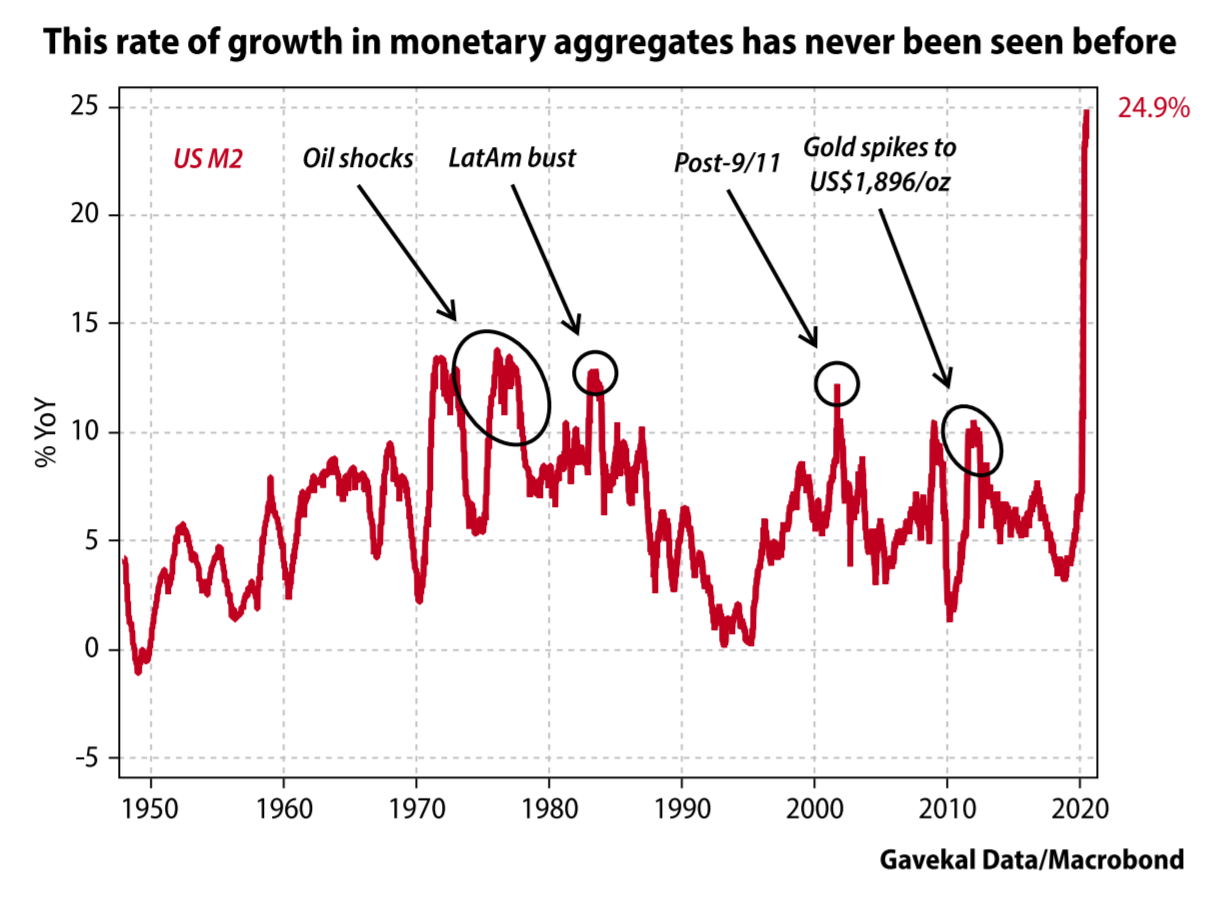
Finance 101 teaches that the price of an equity is determined past a visitor's future cash flows, discounted past an involvement charge per unit, to which is added a risk premium. Theoretically then, to be successful an investor should only take to formulate a view on these three variables. Only is information technology really that elementary? Consider the post-obit:
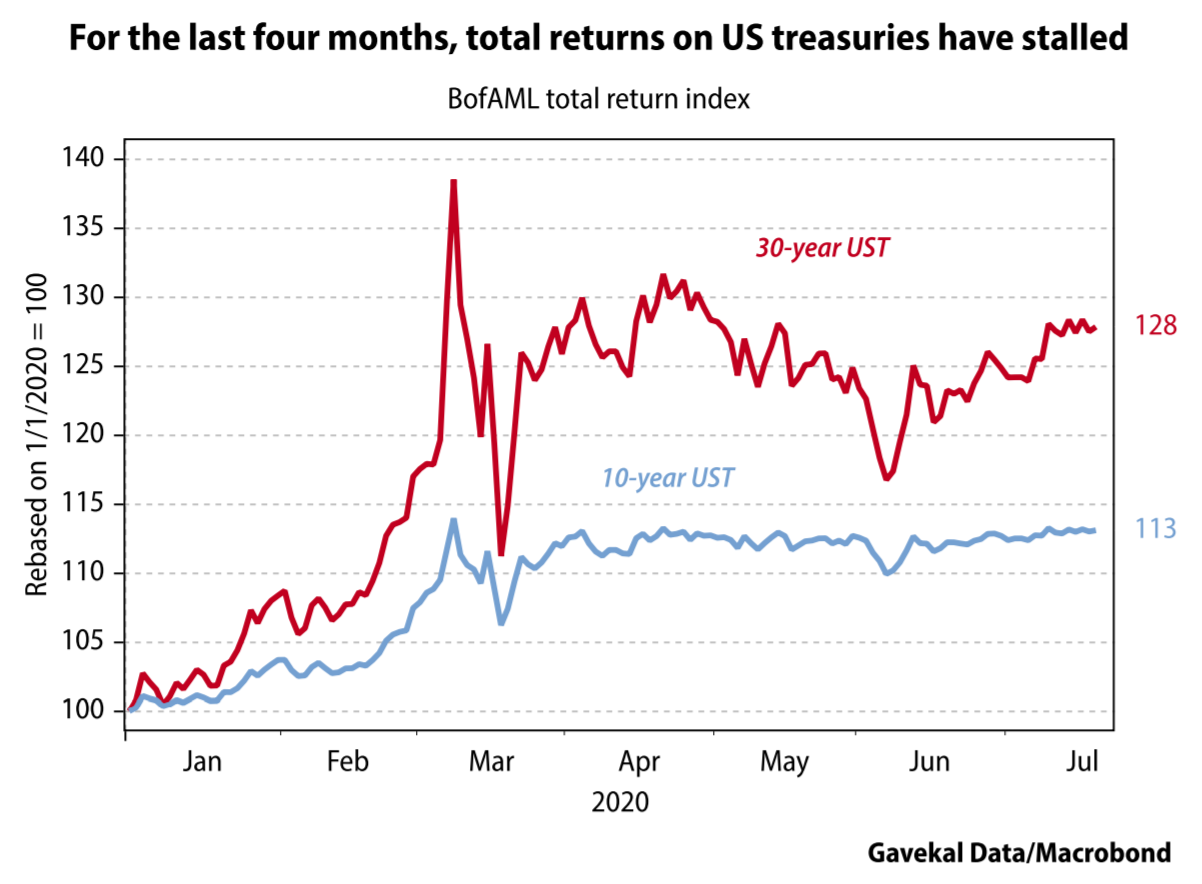
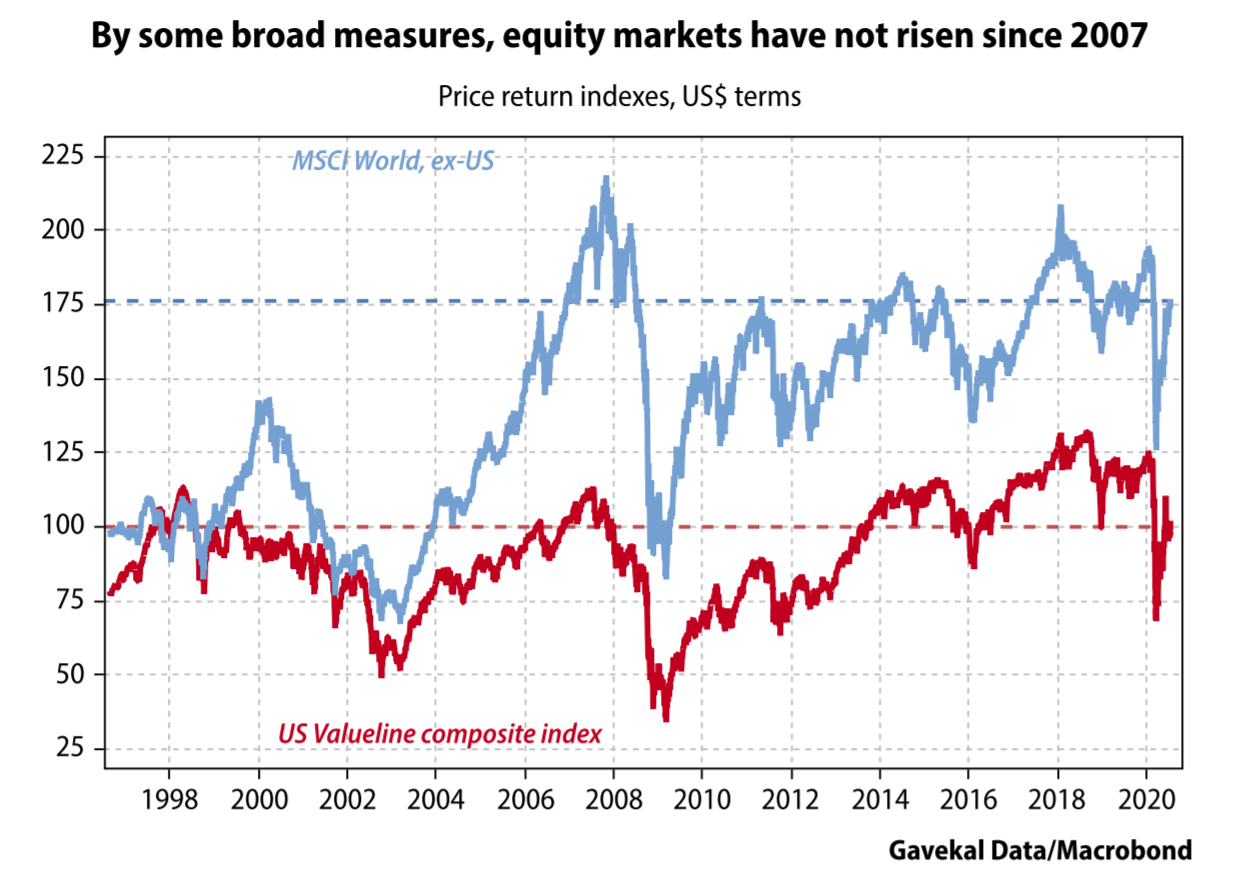
Defining a behave marketplace is like shooting fish in a barrel plenty: if the price of an asset falls past a given corporeality—for equity indexes, commonly -xx%—then it is generally accustomed that the asset is in a deport market. But if it is to exist useful, the definition of a bull market needs to be more than complicated. The financial media ordinarily talk about a 20% rising equally a "balderdash market," but that hardly seems satisfactory. Under that definition, oil, which has more than doubled from its mid-April lows, would be in a balderdash market. Yet, very few energy investors take been popping the champagne corks lately.
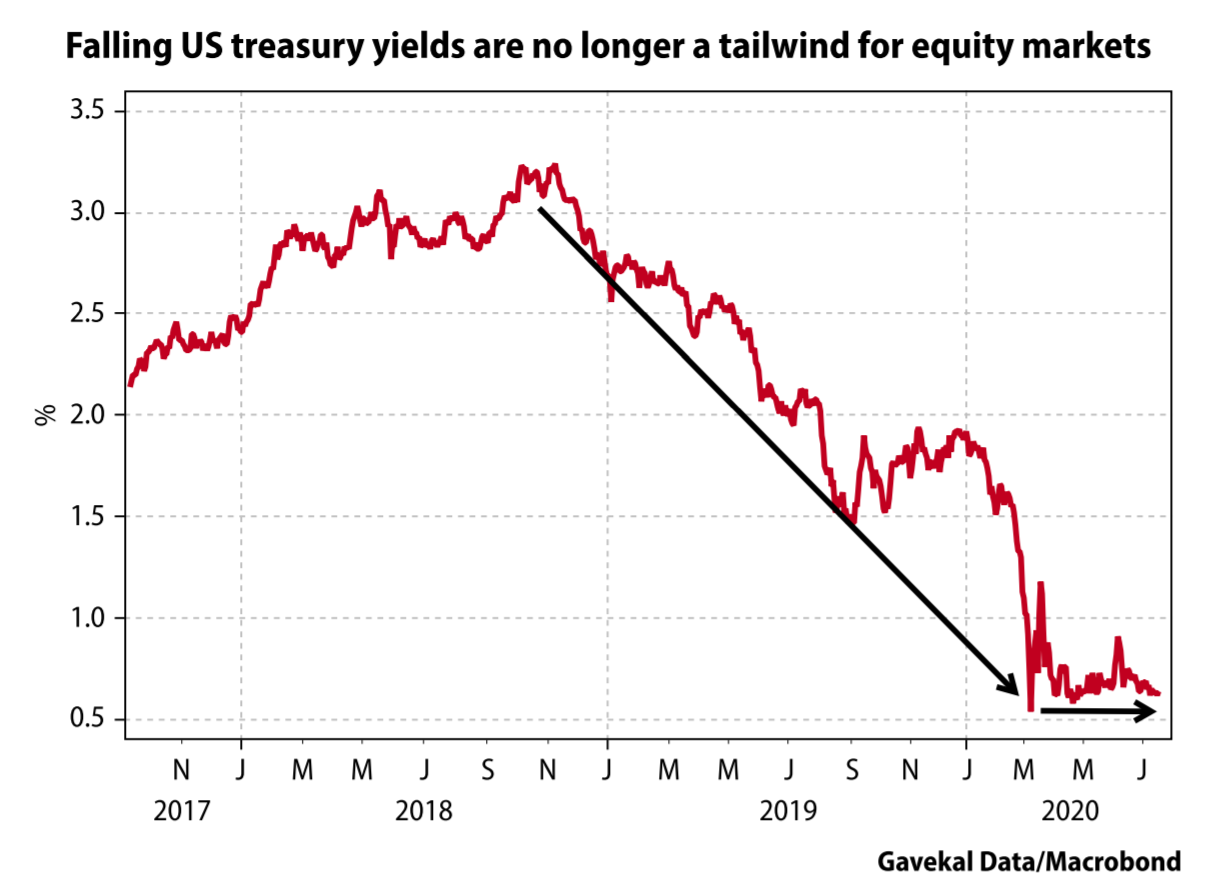
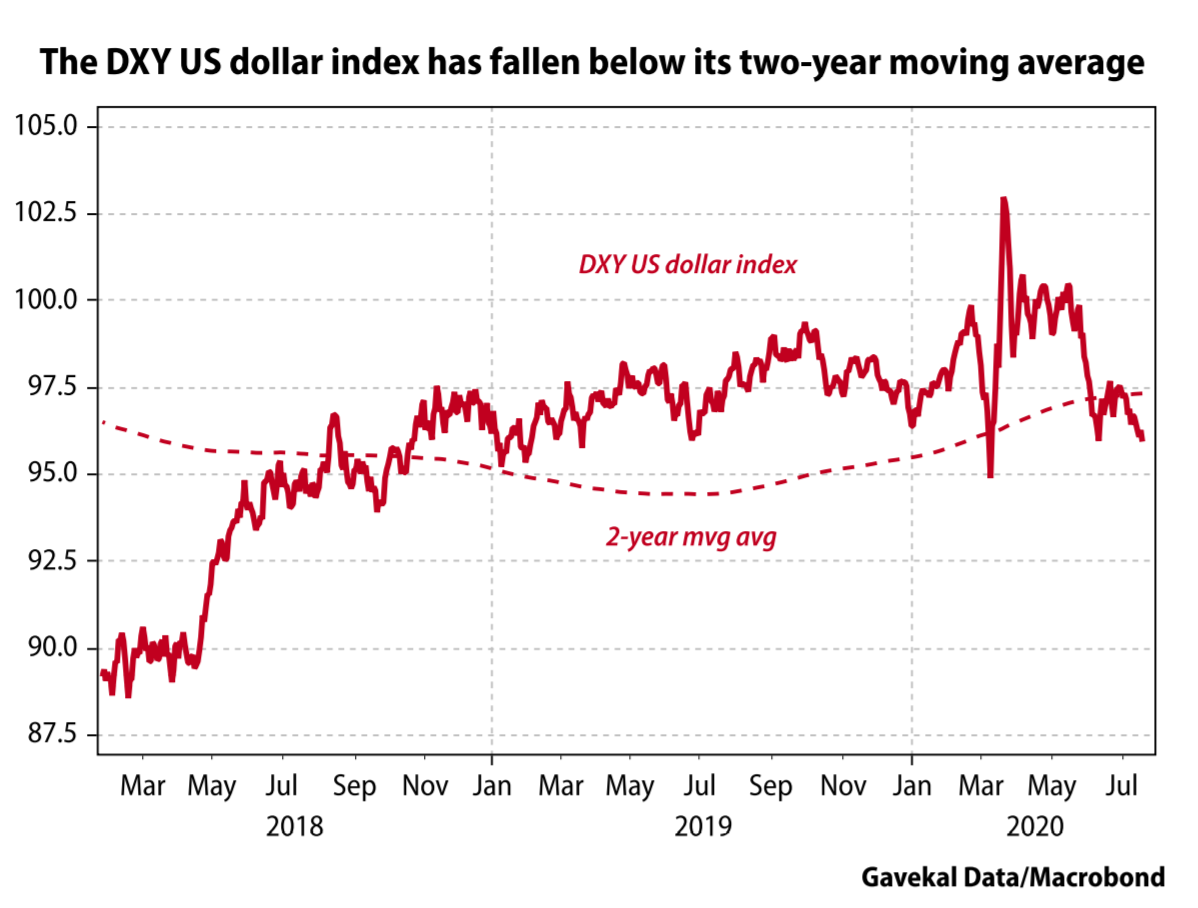
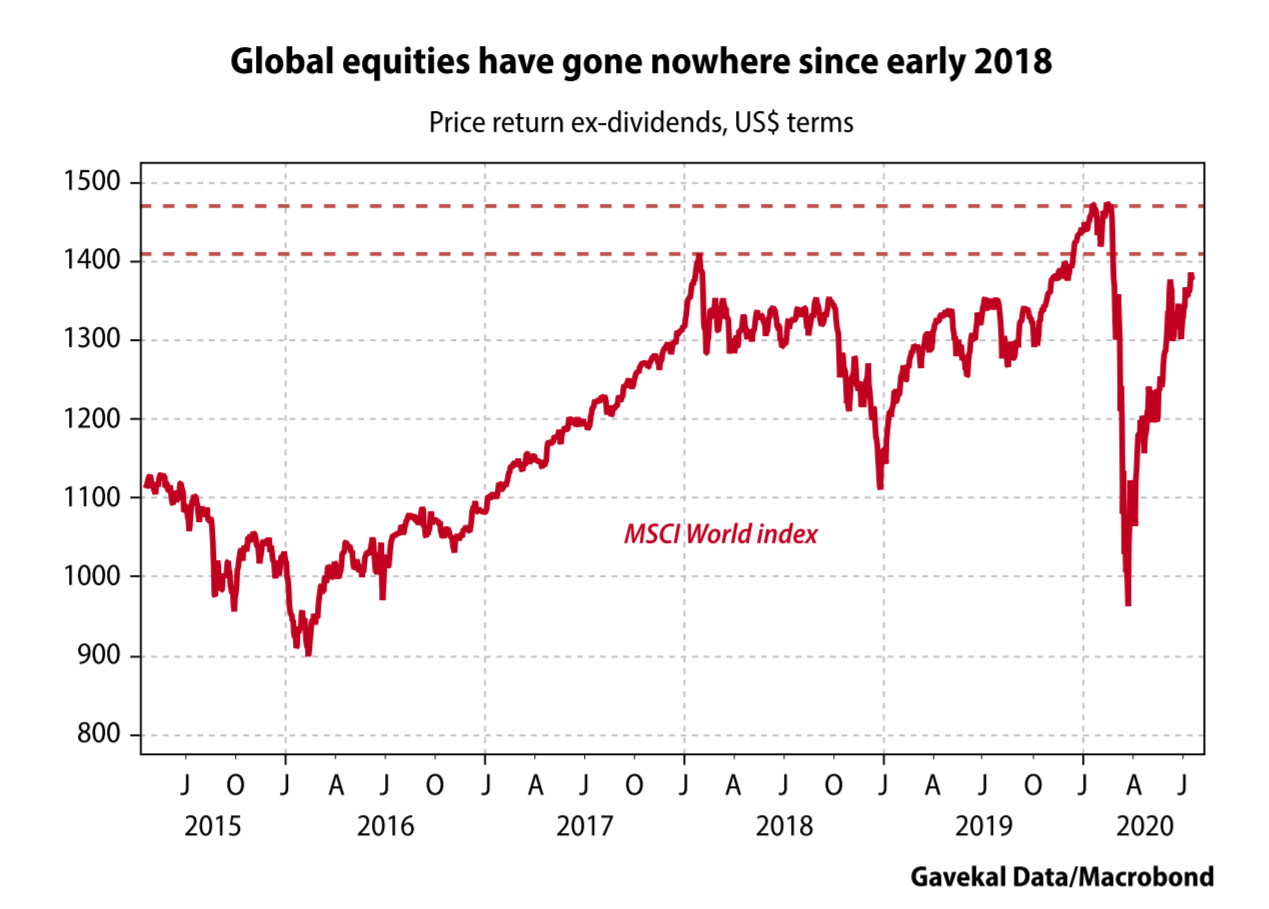
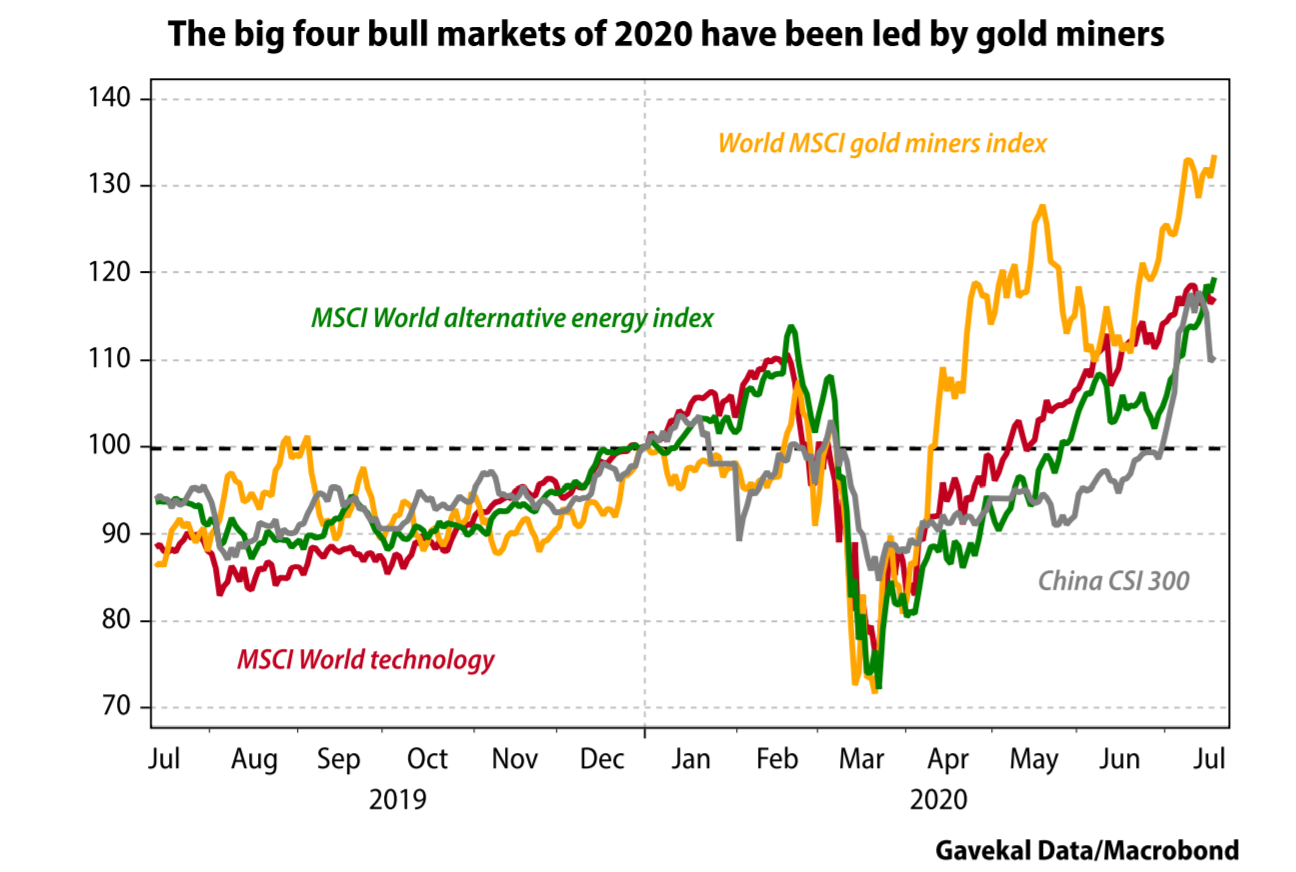
Many liters of ink accept been spilled over the Big Tech bull market. The subject area is unavoidable, if only because Facebook, Amazon, Apple, Microsoft and Google now account for more than a 5th of the Southward&P 500. As a outcome, the decision either to overweight or to underweight Big Tech has made or broken many portfolio managers' performance in recent years. And it's likely to continue to practice so for a good few years to come.
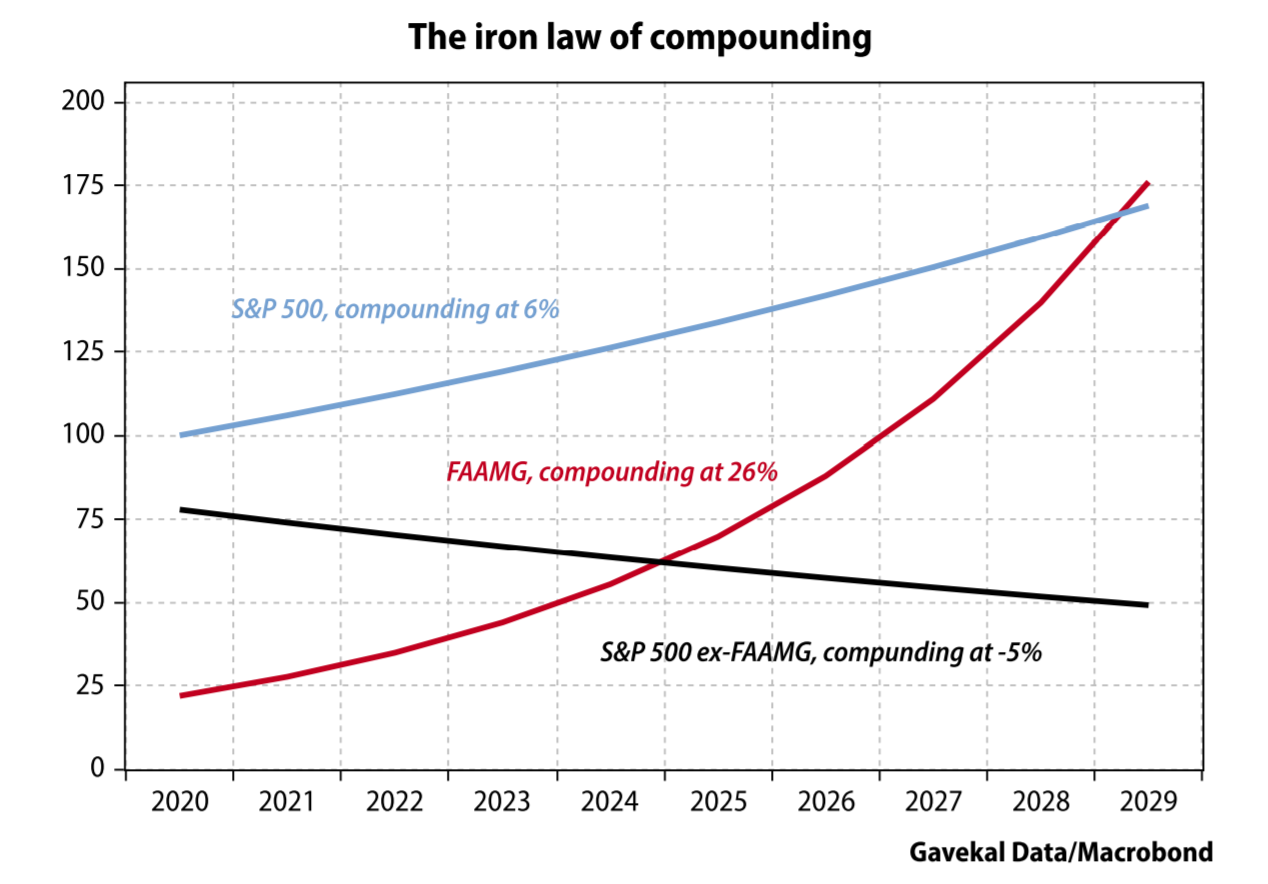
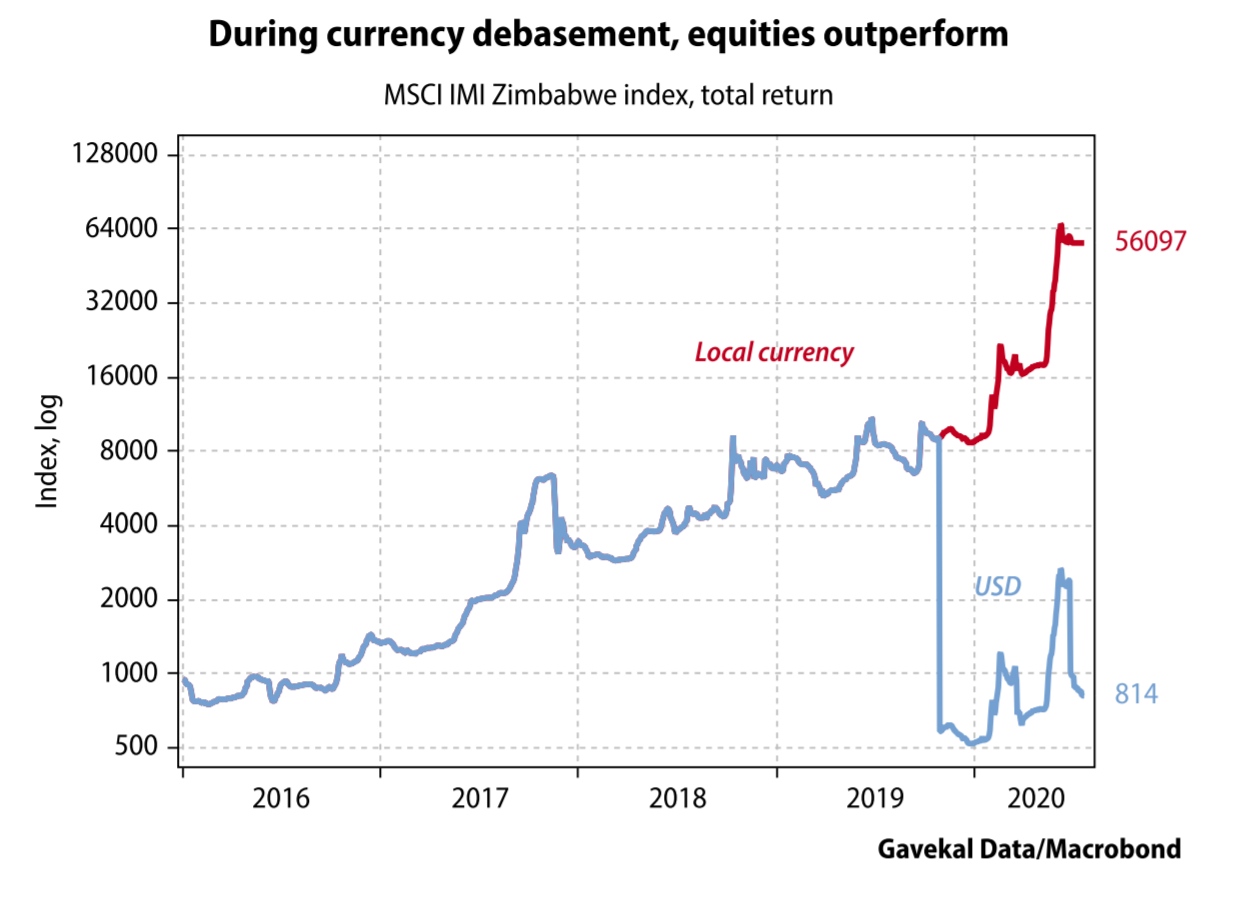
In the nautical chart below, the red line tracks the performance of alternative energy stocks around the globe. The blue line tracks the performance of more traditional energy providers—mostly oil producers, some natural gas, and a tiny fiddling bit of coal. For virtually of the by six years, these ii energy provider segments delivered roughly the aforementioned performance.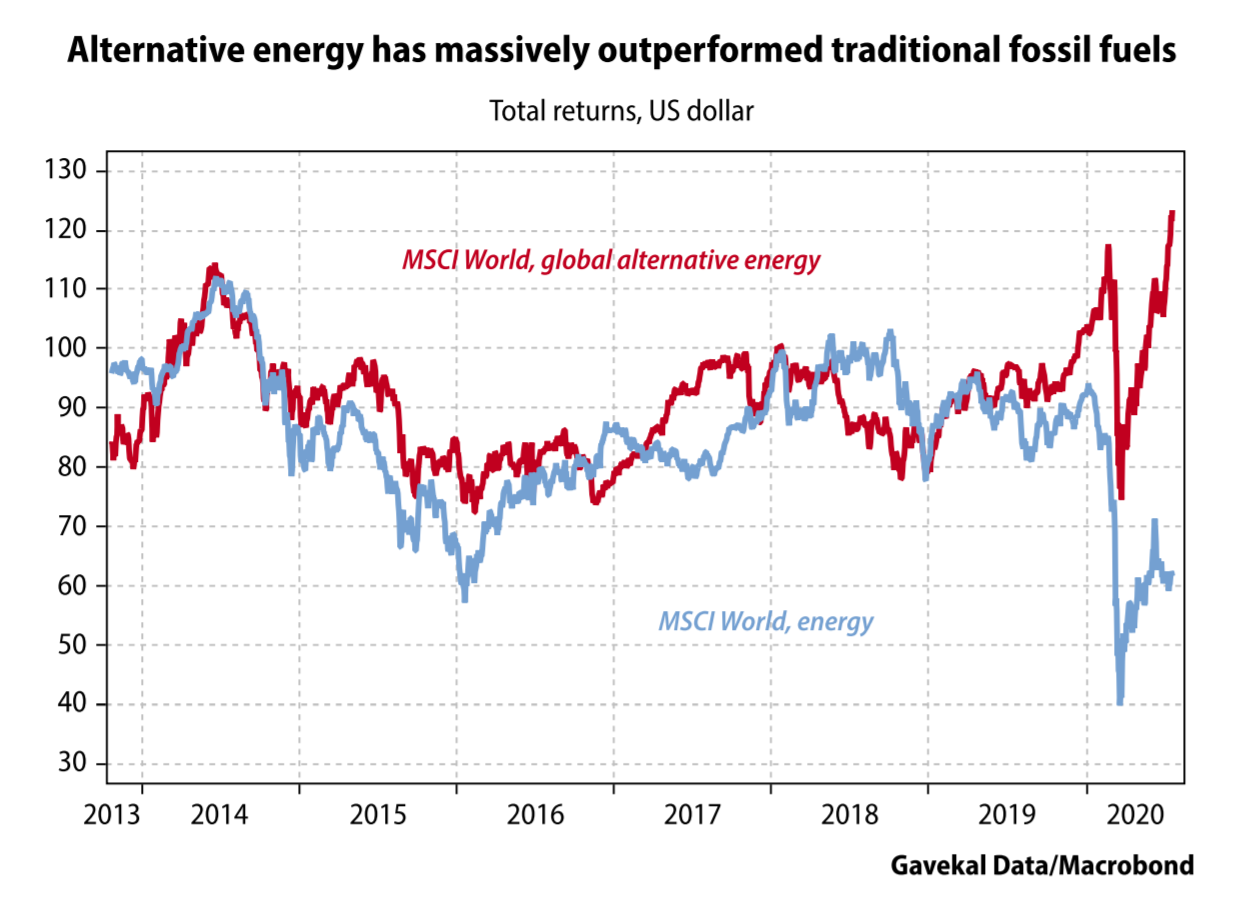
Yr-to-date, gold and silver miners have outperformed all other major asset classes. This outperformance has come confronting a backdrop of steadily rising gold prices, and sharp rallies in silver prices. Aureate has at present made new all-time record highs in every currency except the U.s.a. dollar. And when it comes to the US dollar, if you lot look at quarterly averages for the price of gold, and then the boilerplate price in 2Q20 of US$i,780/oz was a shade to a higher place the average cost of US$1,772 at the pinnacle of the previous bull marketplace in 3Q12.
With Covid-19 originating in Mainland china, the US-China human relationship deteriorating further, China imposing a highly unpopular security law on Hong Kong, global merchandise collapsing, the UK banning Huawei, China and India coming to blows in the Himalayas, and the Chinese government doing far less fiscal and monetary stimulus than whatever other major government, who would have thought that the CSI 300 would be outperforming all other major markets year-to-appointment, except for the Nasdaq? However, that is exactly what is happening. And merely as success has many fathers, there are probably several germinal forces behind the rising Chinese equity market.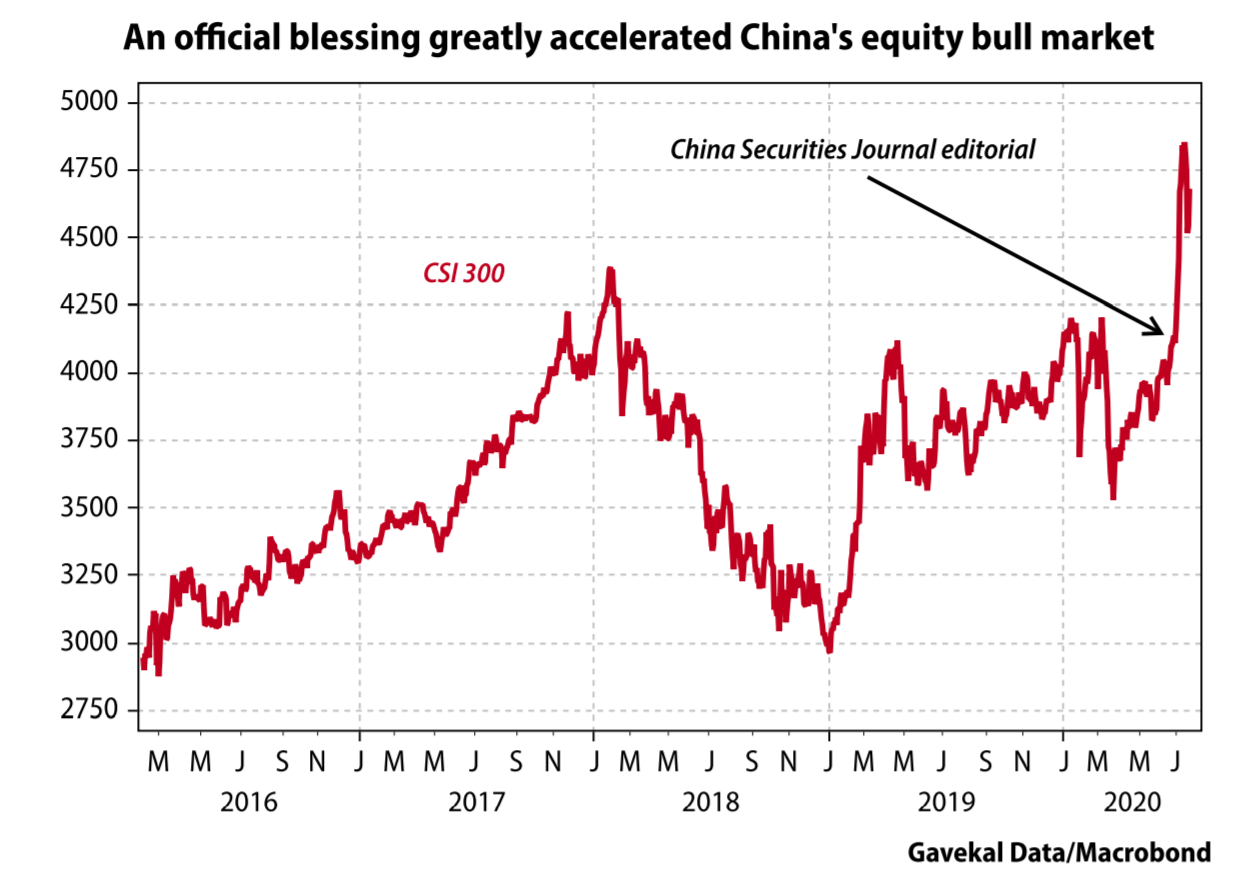
Source: https://evergreengavekal.com/the-consequences-of-worthless-cash/
0 Response to "what gold to buy if paper money becomes worthless"
Postar um comentário